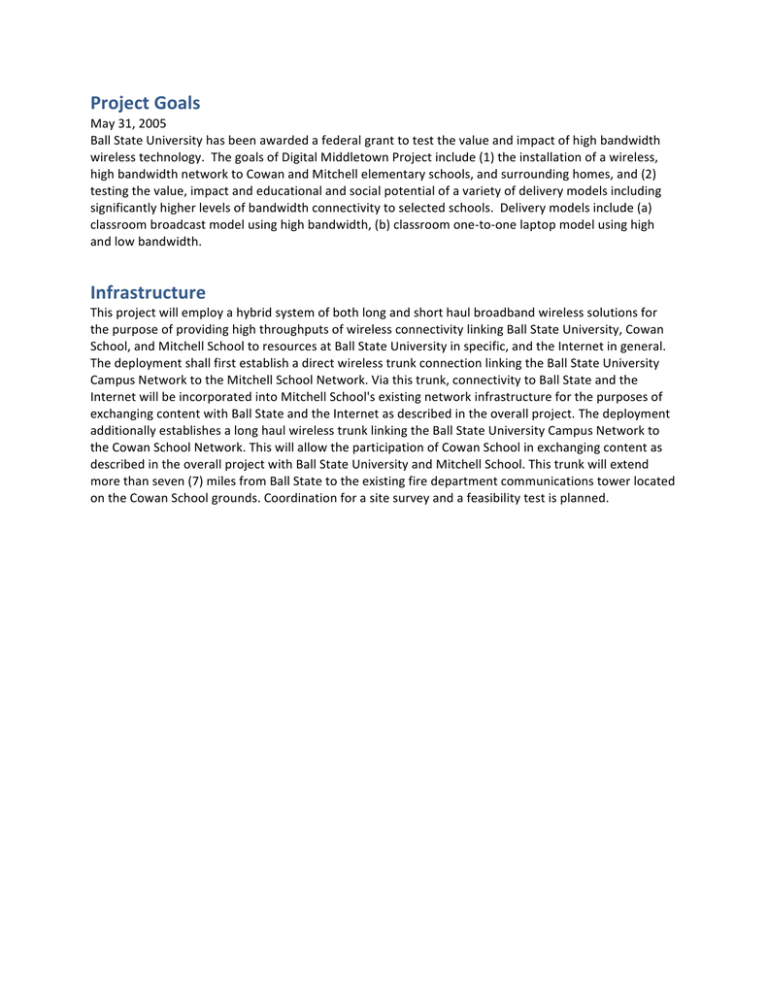Document 10920646
advertisement

Project Goals May 31, 2005 Ball State University has been awarded a federal grant to test the value and impact of high bandwidth wireless technology. The goals of Digital Middletown Project include (1) the installation of a wireless, high bandwidth network to Cowan and Mitchell elementary schools, and surrounding homes, and (2) testing the value, impact and educational and social potential of a variety of delivery models including significantly higher levels of bandwidth connectivity to selected schools. Delivery models include (a) classroom broadcast model using high bandwidth, (b) classroom one-­‐to-­‐one laptop model using high and low bandwidth. Infrastructure This project will employ a hybrid system of both long and short haul broadband wireless solutions for the purpose of providing high throughputs of wireless connectivity linking Ball State University, Cowan School, and Mitchell School to resources at Ball State University in specific, and the Internet in general. The deployment shall first establish a direct wireless trunk connection linking the Ball State University Campus Network to the Mitchell School Network. Via this trunk, connectivity to Ball State and the Internet will be incorporated into Mitchell School's existing network infrastructure for the purposes of exchanging content with Ball State and the Internet as described in the overall project. The deployment additionally establishes a long haul wireless trunk linking the Ball State University Campus Network to the Cowan School Network. This will allow the participation of Cowan School in exchanging content as described in the overall project with Ball State University and Mitchell School. This trunk will extend more than seven (7) miles from Ball State to the existing fire department communications tower located on the Cowan School grounds. Coordination for a site survey and a feasibility test is planned. Network Design: Cowan Elementary School April 5, 2005 Cowan Elementary Network Topology Cowan Elementary is connected with a 24Mbps (12 Mbps symmetrical) half-­‐duplex wireless backbone connection to Ball State University's data network. This first link connects Ball State University to the Cowan Fire Department. Within the fire department, a network switch provides 10/100 Mbps data connections. From the Cowan Fire Department, another wireless point-­‐to-­‐point link connects to Cowan Elementary. The wireless point-­‐to-­‐point connection from the Fire Department to Cowan Elementary is a 20 Mbps half-­‐duplex link. Within Cowan Elementary, data equipment has been installed to provide 10/100 Mbps wired data connections and three access points of 802.11g with speed of 54Mbps. A long haul wireless trunk extending over 6 miles linking the Ball State University Campus Network to the Cowan School. Cowan Elementary School Network Design Legend April 6, 2005 IP address range 12.159-­‐209.64 – 12.159.209.127 • subnet mask 255.255.255.192 • default gateway 12.159.209.65 BSU Cisco3550, 12.159.209.65 Cowan Elem. Cisco 2900xl, 12.159.209.66 Tsunam1 QB20 (fire station, 12.159.195.67 Tsunami QB20 (cowan elem.), 12.159.209.68 SchoolboardAP, 12.159.209.69 tcomAP, 12.159.209.70 ResourcermAP, 12.159.209.71 TC-­‐10-­‐1, 12.159.209.72 Tsunami 10 (Teachers College) Tsunami 10 (fire station) DHCP address range: 12.159.209.75 -­‐ 12.159.209.127 Cowan Fire Station Legend IP address range 12.159-­‐209.248 – 12.159.209.255 • subnet mask 255.255.255.248 • default gateway 12.159.209.249 Cisco 2900xl, 12.159.209.250 DHCP address range: 12.159.209.251 – 12 .159.209.254 Network Design: Halteman Village Neighborhood, April 5, 2005 The Scheidler Tower connection uses two Alvarion Base Stations BreezeAccess 5.8 GHz with each with a120 degree antenna and the Alvarion Base Station BreezeAccess 900 MHz has a single 360 degree omni antenna. The BreezeAccess 5.8 GHz is listed to run 54 Mbps and the BreezeAccess 900 MHz is capable of bandwidth of up to 3 Mbps. Tradeoffs between the two technologies: 1. The higher the frequency the higher the speeds and less penetration. 2. The lower the frequency the better the distance and penetration through obstacles. The Neighborhood connection uses ten Pedestals with Alvarion BreezeAccess 5.8 GHz Subscriber Units that connect back to the Alvarion BreezeAccess 5.8 GHz Base Stations located at the Scheidler Tower. The ten pedestals then takes the signal from the BreezeAccess unit and converts it to a Cisco access point to provide 802.11g WiFi access to "within wireless range" houses. In addition to this, the plan is to install six Alvarion BreezeAccess 900 MHz Subscriber Units at the selected neighborhood homes, which are not within range of a pedestal site, or at distances greater than the range of the 5.8 GHz system. Pedestal was designed and developed at Ball State University by the DMP Network team. Network Design: Mitchell Elementary School Mitchell Elementary has received a 60Mbps (30Mbps symmetrical) half-­‐duplex wireless backbone connection to Ball State University's data network Within Mitchell Elementary, data equipment has been installed to provide 10/100 Mbps wired data connections. To supplement the wired connections, four "access points" have also been installed throughout the school. Each access point is configured with 802.11g radios. These access points provide all wireless connected devices the opportunity to connect at a shared speed of 54Mbps. A direct wireless trunk connection linking the Ball State University Campus Network to the Mitchell School. Mitchell Elementary School Legend: IP address range 12.159-­‐195.0 – 12.159.195.63 ·∙ subnet mask 255.255.255.192 ·∙ default gateway 12.159.195.1 BSU Cisco3550, 12.159.195.1 Mitchell Elem. Cisco 2900xl, 12.159.195.2 Tsunam1 QB60 (Scheidler Apt ), 12.159.195.3 Tsunami QB60 (Mitchell Elem.), 12.159.195.4 AduitoriumAP, 12.159.195.5 EastAP, 12.159.195.6 SouthAP, 12.159.195.7 NorthAP, 12.159.195.8 DHCP address range: 12.159.195.10 -­‐12.159.195.62 Interview Phase Ends The interview phase for the Digital Middletown project ends on April 30, 2005. Internet access into the home will continue, but the in-­‐home interviews will end.




